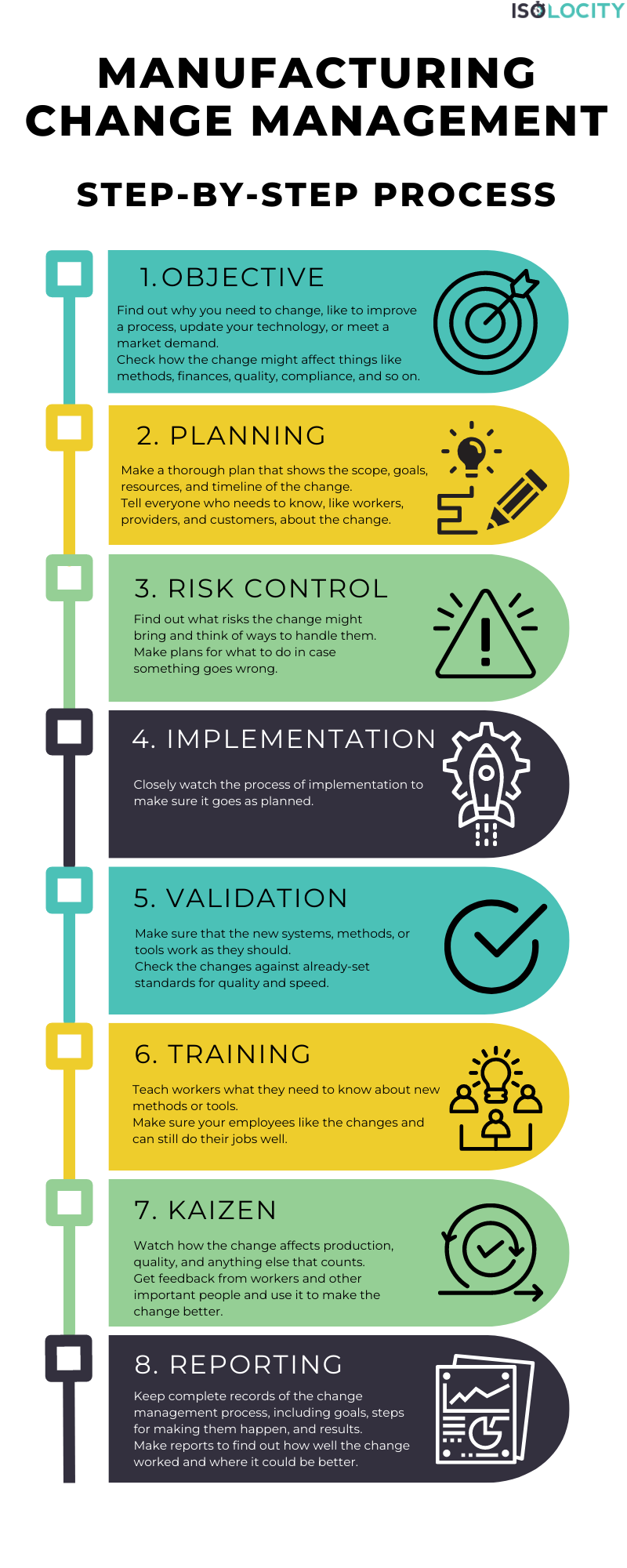In the world of making things, change is always going on. Change is inevitable, whether it’s bringing in new technologies, updating methods, or adjusting to what the market wants. However, handling these changes effectively is essential to maintain stable, efficient, and high-quality manufacturing processes. Manufacturing Change Management comes into play at this point.
In addition to reading, you can watch this blog about Manufacturing Change Management too!
Manufacturing Change Management: Why It’s Important
- Minimizing Disruptions: Effective change management reduces the likelihood of production interruptions, ensuring industrial processes operate with minimal downtime.
- Risk Management: Change can put quality, safety, and compliance at risk. Change management that works well looks for these risks and takes steps to reduce them.
- Maintaining Quality: Changes can have an unintended effect on the quality of a product. By keeping up with changes, manufacturers can make sure that their products meet or exceed quality standards.
- Resource Optimization: Change management helps make the best use of resources, avoiding waste and making sure they are used for what they were made for.
- Regulatory Compliance: Regulatory standards must often be met when making things. Change management makes sure that changes are in line with these standards, which keeps legal problems from happening.
- Employee Engagement: Involving workers in the change process provides them with a sense of control, boosts morale, and facilitates their adaptation to new methods.
Process of Manufacturing Change Management Step-by-Step
-
Seeing change and judging it
Find out why you need to change, like to improve a process, update your technology, or meet a market demand.
Check how the change might affect things like methods, finances, quality, compliance, and so on. -
Planning and talking about plans
Make a thorough plan that shows the scope, goals, resources, and timeline of the change.
Tell everyone who needs to know, like workers, providers, and customers, about the change. -
Taking risks into account and cutting them down
Find out what risks the change might bring and think of ways to handle them.
Make plans for what to do in case something goes wrong. -
Put the change into action by following the plan that was made.
Closely watch the process of implementation to make sure it goes as planned.
-
Tests and Validation
Make sure that the new systems, methods, or tools work as they should.
Check the changes against already-set standards for quality and speed. -
Education and training
Teach workers what they need to know about new methods or tools.
Make sure your employees like the changes and can still do their jobs well.
-
Always keeping an eye on things and making changes
Watch how the change affects production, quality, and anything else that counts.
Get feedback from workers and other important people and use it to make the change better. -
Keeping track of things and reporting on them
Keep complete records of the change management process, including goals, steps for making them happen, and results.
Make reports to find out how well the change worked and where it could be better.
Examples of Automating the Manufacturing Change Management Process:
Process Automation: Using robotic technology on an assembly line to make it work better and save money on labour.
New Material: Adding a new raw material to the process of making something and making sure it meets quality standards.
Implementing Lean Manufacturing: Switching from standard manufacturing to lean principles to reduce waste and make the process more efficient.
Manufacturing Change Management: Best Practices
- Making plans early: Start planning for the change a long time before it happens so you can find possible problems and use your resources well.
- Cross-Functional Collaboration: Have people from different areas work together to make sure everyone knows how the change will affect everything.
- Clear Communication: Keep the lines of communication open and honest with everyone involved in the change process.
- Participation of workers: Include workers in the planning and implementation process, taking their ideas and concerns into account.
- Risk Assessment: Carefully look at the possible risks and come up with ways to deal with them to avoid problems.
- Testing and Validation: Before the change is fully put into place, it should be tested in a controlled setting to find any problems.
- Continuous Monitoring: Keep an eye on the change’s effects even after it’s been put into place to make sure it works well in the long run and find places where it could be better.
What Quality Management Software Does for Manufacturing Change Management
Quality Management Software (QMS) is a key part of Manufacturing Change Management because it gives an organized way to handle changes and keep quality high. Here’s what QMS brings to the table:
- Document Control: The document management module helps manage documents linked to the change process. This makes sure that everyone involved has access to the most up-to-date information.
- Risk Management: The QMS helps find, evaluate, and reduce the risks that come with the change. This makes sure that industry rules are met.
- Audit Trails: QMS keeps a full audit trail of all changes made, which allows for accountability and openness.
- Training and Competency Management: The QMS helps plan and track training for new processes for employees, making sure that everyone is ready for the change.
- Non-Conformance Management: If the change causes non-conformances, the QMS can help handle and fix them in a way that keeps them from happening again.
- Continuous Improvement: The QMS gives you tools to track how the change affects things and make any needed changes to improve speed and quality over time.
Manufacturers can make sure transitions go smoothly, keep product quality up, and drive business excellence by using a structured approach, involving stakeholders, and using technology like Quality Management Software. Successful manufacturing businesses accept change and figure out how to deal with its effects.





